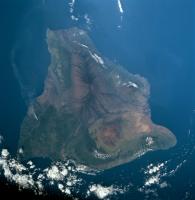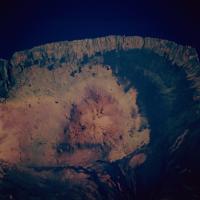 The island of Hawaii is made up of 5 huge volcanoes of which Mauna Loa
is the worlds largest mountain by volume, Mauna Kea is the worlds highest mountain measured from base to top
(half of it happens to be underwater) and Kilauea which is the worlds most active volcano.
The island of Hawaii is made up of 5 huge volcanoes of which Mauna Loa
is the worlds largest mountain by volume, Mauna Kea is the worlds highest mountain measured from base to top
(half of it happens to be underwater) and Kilauea which is the worlds most active volcano.
In this view it can clearly be seen how the island is dominated by Mauna Loa and its numerous lava flows. Kilauea is the bottom left section of the island and the smoke plume from Pu'u'O'o cone can clearly be seen. Kilauea's summit caldera is to the top right of the base of the smoke plume where the colours change from greens to browns. The vilage of Volcano is situated just below the caldera in the picture.
Hilo can be seen at the bottom centre of the image, just above where the clouds are. Note the 1984 lava flow that can be seen on the slopes of Mauna Loa heading towards Hilo.
Mauna Kea is the reddish/brown peak to the lower right of the island centre. The division between Mauna Loa and Mauna Kea is clearly marked by the edge of the black lava flows along the saddle between the two mountains. Pearched ontop of the mountain it is just possible to make out some white spots representing the telescopes. If you know what you are looking for the JCMT's spot can be seen in millimetre valley (however it is much easier to see in the next picture). The picture was taken in August 1997.
The image is available in four different sizes:
Note that the 'huge' version will decompress to around 75MB so if your computer doesn't have at least 64MB of RAM you will probably crash it! This version is a resaved version of the orginal 11MB JPG available at the Earth from Space site, so this version has very slightly lower quality (it is hardly noticable however). Mauna Kea is the Earth's highest mountain, as measured from its base on the
ocean floor to the top of its highest peak it is somewhat over 10.5km tall (cf. 8.8Km for Mt. Everest, note, however, that it isn't particuarly big
compared to the Solar System's largest volcano, Mars' Olympus Mons which is arround 26km high). It has a
volume of 30,000 km3, second only in volume to Mauna Loa on planet Earth. The top coastline is the
Hamakua coast, the upper sections of Hilo are just visible at the far right of the image, the rest of Hilo is
just off the right edge of the image. The top left section of the island with the deep
valleys is Waipio valley.
Mauna Kea is the Earth's highest mountain, as measured from its base on the
ocean floor to the top of its highest peak it is somewhat over 10.5km tall (cf. 8.8Km for Mt. Everest, note, however, that it isn't particuarly big
compared to the Solar System's largest volcano, Mars' Olympus Mons which is arround 26km high). It has a
volume of 30,000 km3, second only in volume to Mauna Loa on planet Earth. The top coastline is the
Hamakua coast, the upper sections of Hilo are just visible at the far right of the image, the rest of Hilo is
just off the right edge of the image. The top left section of the island with the deep
valleys is Waipio valley.
From the edge of the image closest to Hilo the Saddle road can be seen winding its way up the saddle bewteen Mauna Loa and Mauna Kea. Note the fresher looking lava tongue from the 1984 flow heading towards Hilo. It is, with difficulty, possible to spot the Kipuka that marks the turn off for the Mauna Kea summit road, although the road itself is not visible.
Further up Hale Pohaku (HP), the mid station with overnight facilities for astronomers, can be made out as a fuzzy area at the base of the upper sections of the mountain (amongst the cinder cones where the color changes from a lighter to a darker red/brown. Above HP the summit road switchbacks can be seen rising towards the summit. Finally, at the summit all the telescopes are clearly visible. scattered over the cinder cones and the JCMT down in millimetre valley. The picture was taken in April 1993.
The image is available in four different sizes:
The top resolution image is also available in a cropped version showing only the summit region: